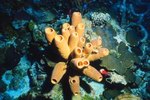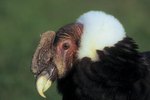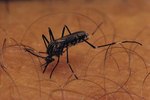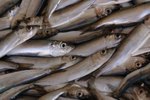
For the past 400 years, humans have been the leading cause of animal extinctions -- humans are responsible for approximately 75 percent of the extinctions during this period. Habitat destruction is a primary cause for these extinctions, but overharvest and introduced species also cause species extinction. Regardless of the causes, many endangered animals share similar traits, such as extreme habitat or food specialization, large size and slow reproductive rates.
Home is Where the Habitat Is
Habitat destruction is the leading cause of species decline in the modern world. Some species that are able to adapt to a variety of habitats manage to survive, but many habitat specialists quickly become endangered when humans, weather or other natural forces, destroy their habitat. The Florida cricket sparrow (Ammodramus savannarum) is an extreme habitat specialist, adapted to living in the dry prairies that historically stretched from Lake Okeechobee to central Florida. While their habitats are being protected, their population remains very low, demonstrating the importance of protecting habitats before species begin to decline in number. Habitat specialization also endangers many bats; if a single cave is compromised, tens of thousands of bats become homeless.
Picky Eaters on the Precipice
Many different types of endangered species specialize on a particular type of food. Listed as critically endangered by the IUCN Red List, scientists suspect that only 100 breeding pairs of Ridgeway’s hawks (Buteo ridgewayi) survive in their Caribbean homeland. In a 2013 study of the species’ ecology, scientists from York University, Ontario, Canada and the Wildlife Preservation Trust Canada, Guelph, Ontario, Canada found that 65 percent of the hawk’s diet was composed of lizards; one genus appeared particularly important, forming 35 percent of the species total diet. Pandas, who rely primarily on bamboo for food, and black-footed ferrets, which chiefly prey on prairie dogs, are additional examples of endangered dietary specialists.
Selected for Survival
Though the distinction is not black and white and some ecologists debate the merits of the distinctions, most recognize that organisms tend to exist at either end of a reproductive spectrum. Animals hailing from stable habitats, usually have slow reproductive rates, and allocate a high amount of energy to a small number of offspring. These animals reach populations that approach the carrying capacity of their habitat; because biologists use the capital letter "K" to denote carrying capacity in ecological equations, these animals are called K-selected. At the opposite end of the spectrum, animals limited by reproductive rate -- reproductive rate is denoted by a lowercase "r" algebraically -- live in chaotic habitats, mature quickly and produce a high number of young. Because r-selected species rebound quickly after population reductions, they are somewhat insulated against extinction. Conversely, K-selected species are very susceptible -- sea turtles, elephants, lemurs, gorillas, tigers and many other critically endangered species are K-selected.
The Bigger They Are, the Harder They Fall
Large animals require larger habitats and more resources than smaller animals do, so they run out before smaller animals do. Additionally, large animals are more likely to be prey for the apex predator in most ecosystems. However, some scientists dispute this principle, and suggest that geography, human population density and phylogeny are better at predicting which species will disappear than size is. Nevertheless, many of the planet’s largest animals -- including hippopotamuses, polar bears, rhinoceroses, crocodiles and whales -- are in danger of becoming extinct.
References
- University of Florida: Threatened and Endangered Species
- Audubon of Florida: Florida Grasshopper Sparrow: Endangered Species in Freefall
- Journal of Field Ornithology: Feeding Ecology and Specialist Diet of Critically Endangered Ridgway's Hawks
- University of Miami: R and K selection
- World Wildlife Fund: Leatherback Sea Turtle
- Proceedings of the Royal Society: The Predictability of Extinction: Biological and External Correlates of Decline in Mammals
- The Independent: Hippopotamus Among 26,000 New Species on Endangered List
- IUCN Redlist: Diceros Bicornis
- IUCN Redlist: Ailuropoda Melanoleuca
Resources
Photo Credits
-
Tom Brakefield/Stockbyte/Getty Images




